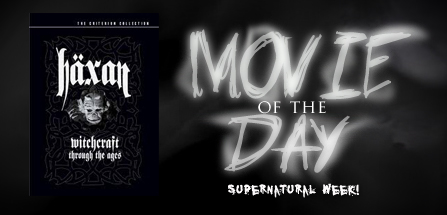The Film: Haxan: Witchcraft Through the Ages (1922)
The Principles: Benjamin Christensen (Writer/Director/Star). Maren Pederson. Clara Pontoppidan. Elith Pio. Oscar Stribolt. Tora Teje. John Andersen.
The Premise: Well…it’s a look at witchcraft. Ya know…through the ages, and all.
Is It Good: So good. It’s a little deceptive right off the top, as the visual aid-intertitle-visual aid slide show style and Christensen’s first-person narration gives it a very academic tone and makes the audience feel like they’re in for a pretty cut and dried documentary. Which isn’t a bad thing in and of itself – the information (and the way it’s presented) is certainly interesting and compelling, and Christensen stays concerned enough with the presentation of it all that it never stops being engaging. Especially when he sprinkles in lines like “The belief in evil spirits, sorcery and witchcraft is the result of naïve notions about the mystery of the universe.” For 1922 that was pretty damned progressive and irreverent. Hell, depending on who you’re talking to it’s still pretty damned progressive and irreverent today.
But as it turns out, the thesis-like presentation was essentially just a prologue and once the film goes into Part 2 (of 7), “irreverent” almost becomes an understatement. From this point on, Christensen trades ancient drawings of witches and evil spirits for fully(and remarkably well)-produced dramatizations that cover everything from love potions to corpse desecration to baby-eating to possessed nuns to naked ritualistic jubilees to lusty trysts with Satan himself (played with palpable glee by Christensen). Christensen never shies away from any of it and because he’s basically mocking all of these beliefs and superstitions, he and the entire cast are having an absolute blast.
But, just like with the prologue, there comes a point where he switches gears again and levity and mockery are traded for thoughtful seriousness as we’re offered a full dramatization of witch-hunters at work, covering everything from the accusation to the execution. And as we watch a poor old beggar woman be arrested, interrogated and tortured into a false, desperate confession that implicates practically everyone she’s ever come in contact with, Christensen segues into his overall point, using science and psychiatry to explain away all of the phenomena that had previous civilizations all in a tizzy.
By the time the credits roll you’re left with a movie that’s almost impossible to classify as a singular thing or file into a singular genre. The fact that it was done that way intentionally – and impeccably – means that yes, it is indeed good.
Is It Worth A Look: As I mentioned earlier it is remarkably well-produced, and on several levels at that. From a production design standpoint the sets, costumes and props are all top-notch. In terms of filmmaking the photography is splendid and the visual effects – stop-motion animation, compositing/keying, even the editing in some shots – are rather ingenious and extremely well-executed. Honestly, for as influential as it feels on not only horror filmmaking but narrative filmmaking in general, I can’t help but be a little curious as to why it isn’t more widely known than it is. So y’all should fix that and watch the hell out of this.
Random Anecdotes: There are three versions of the film floating around, the 1922 original release (which is what’s covered here), a 1941 re-release with different intertitles and a 1968 recut that was only 76 minutes, had a jazz score and was narrated by William S. Burroughs. If the movie itself didn’t make the Criterion DVD worth it all on its own, that would certainly do it.
Cinematc Soulmates: Too many to list, but I’ve seen people hold Christensen up to dudes like D.W. Griffith, Carl Theodor Dreyer and Maurice Torneur. So you could start with those guys!
Note: Since there isn’t a proper trailer, here’s one for a live performance of the film’s score by the Montreal Nintendo Orkestar (it’s what it sounds like, apparently), complete with footage:
